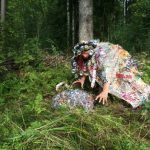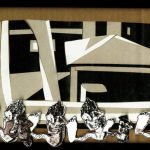Interview | Boshko Boskovic, Program Director of Residency Unlimited
“The crucial part of a successful business relationship is that both parties work together towards a mutual goal and that the roles and expectations are clearly defined."
Boshko Boskovic (born in Belgrade, Serbia) is the Program Director of Residency Unlimited, a residency program for international artists and curators based in New York. He has curated numerous exhibitions and published extensive essays. Boskovic has worked at The Felix Gonzalez-Torres Foundation and as an associate director at the Sean Kelly Gallery in New York.
NYFA: You arrived in the US from France through a university exchange program and ended up with a graduate degree in Curatorial Studies from the University of Louisville. Did you face any challenges at the beginning of your career in the art world as an immigrant?
BOSHKO BOSKOVIC: I have to say that I was very fortunate not to face any challenges as an immigrant at the beginning of my career in the art world. While in graduate school, I had a fellowship as an assistant to Julien Robson, the Contemporary Art Curator at the Speed Art Museum in Louisville, Kentucky. Since Julien is British (Scottish to be more precise), I never felt that I was an outsider. We actually used to joke about certain American modes of being that were completely foreign to us.
NYFA: How did you start your career in the arts and how did you end up working at Residency Unlimited?
BB: I started my career in the arts at the Black and White Gallery, which at the time was based in Williamsburg. There, I worked closely with the owner of the gallery, Tatiana Okshteyn, originally from Russia. I then had a tenure as the associate director at the Sean Kelly Gallery where half of the staff was European at the time. Next was The Felix Gonzalez-Torres Foundation, where I worked on the European retrospective Specific Objects Without Specific Forms; so far that was the most American workplace in my career. I ended up at Residency Unlimited because I knew Nathalie Angles, the executive director, and joined the board while the organization was being created.
NYFA: Your curatorial practice promotes unexpected multicultural relations and realities. Can you tell us what moves this process and if there is a thread that ties all of your projects?
BB: I have been curating and organizing exhibitions for more than a decade and even though it sounds banal, the work of the artist is always what moves my practice. My sensibilities have varied over the years. In the beginning, I worked a lot with video because I was drawn to the medium; it was easy to disseminate and could be produced without a budget. During a period of time, work with a socio-political background was of interest, and also geographic regions that I was very familiar with, such as the territory of ex-Yugoslavia. At times I was specifically commissioned to produce exhibitions with artists from different regions such as Mongolia, Finland, or the United States. I would like to stress that the context of the exhibition venue will often influence what kind of work is shown. A commercial gallery has different priorities from a museum or a university gallery versus a non-profit project space. I was very fortunate to have curated exhibitions in all of the aforementioned venues and enjoyed each one of them for different reasons. The thread that ties all my projects together is that they constitute various branches of the art ecosystem. Together all of them represent the image of the landscape of contemporary visual art. I like the idea of being able to navigate through these different layers that differ from each other yet are part of a whole.
NYFA: Collaboration plays a big role in all that you do. What makes these exchanges so successful? How do you expand your relationships with individual artists and organizations in New York?
BB: Yes, collaborating with other institutions is a big part of our work at Residency Unlimited. The crucial part of a successful business relationship is that both parties work together towards a mutual goal and that the roles and expectations are clearly defined. Good communication is another ingredient that brings forth a good working relationship. We expand our relationships with individual artists by being more involved in their artistic practice and career. It often takes different guises. Sometimes it is through feedback about work that is in its very inception, which personally I enjoy the most. It could be helping artists strategize their career such as finding appropriate galleries to show artwork or pointing out curators that should be aware of their practice. One of the ways to expand relationships with organizations in New York is being curious about cultural entities that exist in our city, learning how they function, and recognizing mutual interests.
NYFA: How do you choose artists to participate in Residency Unlimited programs? What makes an artist an ideal candidate for an RU residency?
BB: There are multiple ways to select artists who participate in our program. For example, through open calls such as the residency program for New York and United States based artists supported by the National Endowment for the Arts. For this program, we usually receive over 300 applications and the invited jury panel selects six artists. Another way to select artists is by invitation as is the case with the Liquitex Cadmium-Free Research Residency; two painters have been invited this year to be part of this exciting program. Our international partners create open calls in their countries and the finalists are selected either by a jury in the country where the applicants are from, by RU or a double jury from RU and the country where the candidate comes from. Artists also apply directly to us and a selection committee reviews applications on an ongoing basis. An ideal artist candidate for a residency at RU is someone who does not have preconceived notions about New York. This is an artist who is willing to experiment and is interested in connecting with fellow residents.
NYFA: As a curator, how do you want to be approached by artists? What advice do you have for immigrant artists looking for opportunities in the city?
BB: I don’t have a recipe as to how I like to be approached by artists. Usually, it starts with a conversation and an inquisitiveness about the work. The advice that I have for immigrant artists looking for opportunities in the city is to search for other like-minded artists with whom you can share your interests and knowledge. It is important to be around individuals with whom you share an aesthetic or intellectual affinity. Artistic practice is often a very solitary endeavor and finding opportunities is always easier when one functions within an artistic community.
Learn more about Boshko Boskovic and Residency Unlimited.
This interview is part of the ConEdison Immigrant Artist Program Newsletter #97. Subscribe to this free monthly e-mail for artist’s features, opportunities, and events here. The Immigrant Artist Mentoring Program is expanding to Newark, NJ through the support of the Ford Foundation and local partners. Apply by October 30, 2017 11:59 PM EST!
– Interview conducted by Alicia Ehni, Program Associate, NYFA Learning.
Image: Boshko Boskovic, Photo: Ara Qiu






